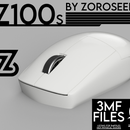Introduction: ZS-F1, F-2, Wireless 3D Printed Finalmouse Ultralight 2 Guide
This mod uses the Logitech G305 PCB. Here are some renders, measurements, and examples of prints.
The ZS-F2 is just a medium sized version of this mouse and all steps are the same.
Supplies
Patience
Basic troubleshooting steps
-G305
-3D Printer or Printed pieces
-Etsy Shop for files and prints: https://www.etsy.com/shop/ZoroSeerus
-Etsy shop file direct link: https://www.etsy.com/listing/961842121/zs-f1-3d-pr...
-Screwdriver
-Tape
-AAA Battery
Cables I use: https://www.amazon.com/gp/product/B07RHVNFQ6
Battery I use: https://www.amazon.com/gp/product/B07QW531W2
-There are likely multiple combinations of chargers and batteries that work. These are the ones I use. The battery matters less than the connector since they'll only vary in weight and battery life. If you get a different battery make sure it's 1.5v.
Video demonstration of rechargeability:
Step 1: Printing Instructions and Considerations
Here are the printing orientations I use. I've printed this on an Ender 3 and Prusa Mini in PLA. My slicers are Superslic3r and PrusaSlicer. I stick close to the provided 0.2mm profiles, with minor tweaks for my particular printers and filaments. In these examples I have ticked "Print Thin Walls" and "Avoid Crossing Perimeters". Use your best judgment when printing.
I print the top piece at a 45 degree angle. You can also use "Place on Face" and the flat spot at the back.
I manually paint supports mainly, but I'm sure you can use the auto-generated ones.
The really small pieces come in four sizes, but you can probably scale their height to whatever works for you if you really want to dial in the clicks.
Step 2: Screws
Here are where all of the screws go.
Use the screws that hold the main switches in place in the G305 to do the same here.
Use the side button screw with the little plastic to hold them in place here as well.
Step 3: Bottom Internals
Slide the PCB into place. You'll need to move it to the right a bit when pushing it down to get around the side button tower.
Do the LMB switch first.
For the side button PCB you'll want to push it gently, and mainly down at the back. DON'T push down at the front. Screw it into place.
If you lost the side button screw with the plastic just use two screws. Screw them slowly. These walls are very thin.
Step 4: Battery
I haven't had any issues with the battery moving but feel free to use some tape to make absolutely sure that neither the battery nor connectors can move.
Slide in the battery. You can do it pushing up from under or from above.
I do the red wire first. Slide the battery forward and then push the negative terminal into place.
Slide the battery back and do the positive end now. Compress the spring a bit and drop it into place. Slot the end into the slit.
Step 5: Side Buttons
Line up the side buttons with their respective screw holes. I find it helpful to hold the side buttons on the other side while screwing them in. Make sure you clean off all supports as even small residue can alter the position of the side buttons due to their thinness.
Step 6: Main Buttons
Screw whichever end you're using into the trigger. You can probably just use the screw, but I have no idea if they would hold their exact position over time which is why I did it this way. The different heights are to alter the click feel, or account for any variances when you print it. I think I tend to use the 0.4mm shorter ones but it'll potentially vary for you.
Alternatively, you can use none and just adjust the screw in or out as desired.
Step 7: Putting It All Together
Make sure to plug in all of your connectors now.
You're aligning the top with the ring on the bottom. Push the front down and into place first. You'll want to push both sides down and then work your way back.
The back isn't flush by design. I am aware that it looks sort of weird, but it was too difficult to pry open before I changed it like this. The flat spot also serves as the initial contact point for the printing bed.
Once it's shut you can test all of your buttons. If you want to use longer or shorter click pieces now is the time to go back and check.
Now just do the last four screws and toss some feet on it.

Participated in the
Self-Care Challenge













